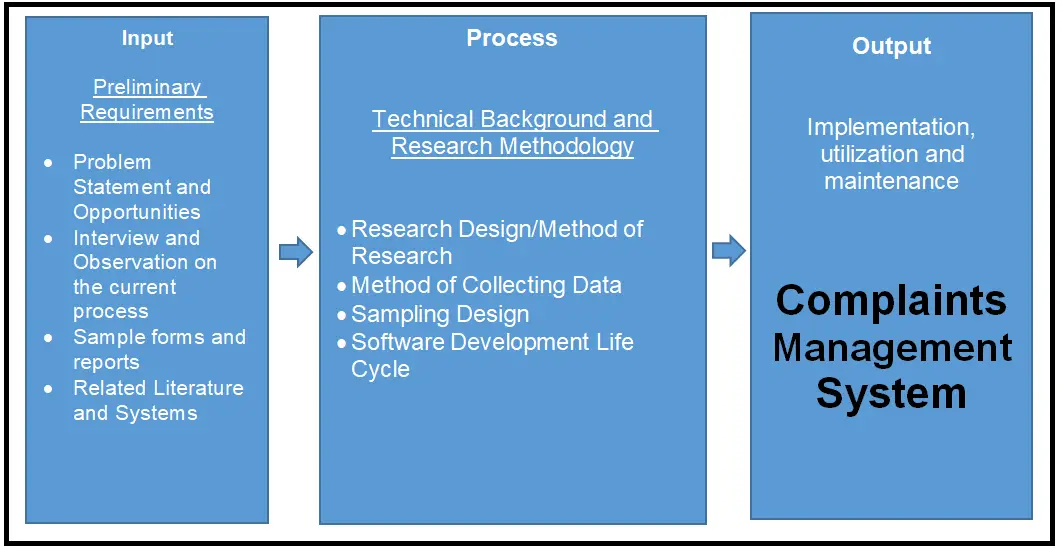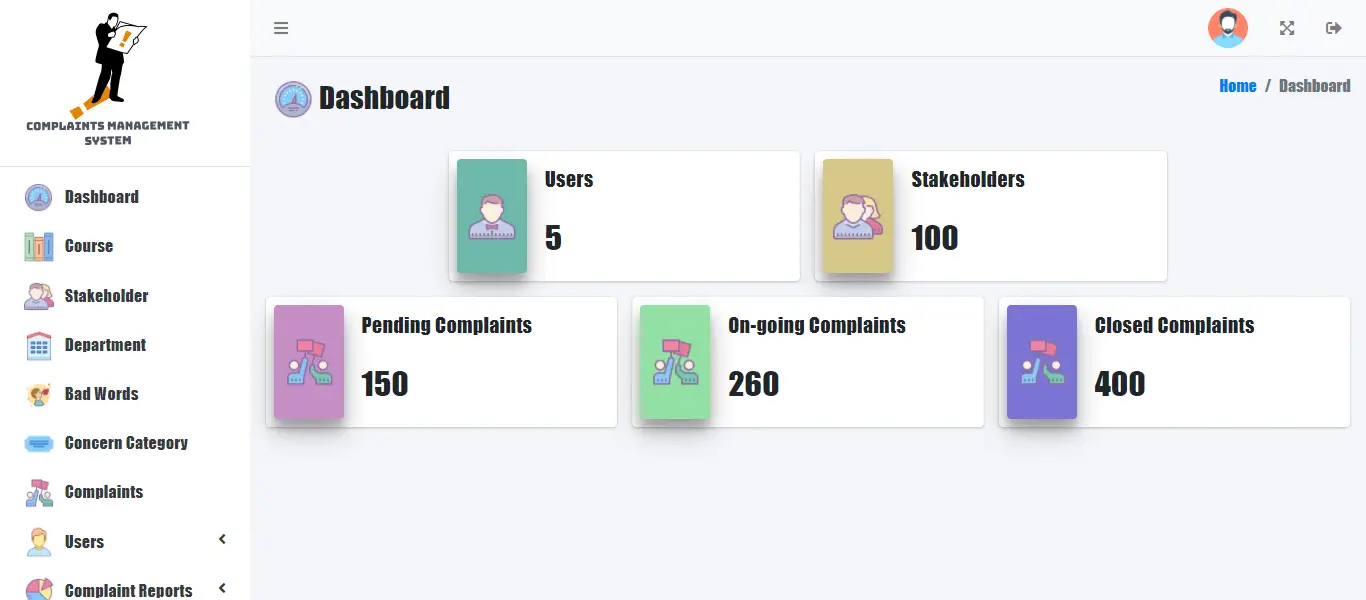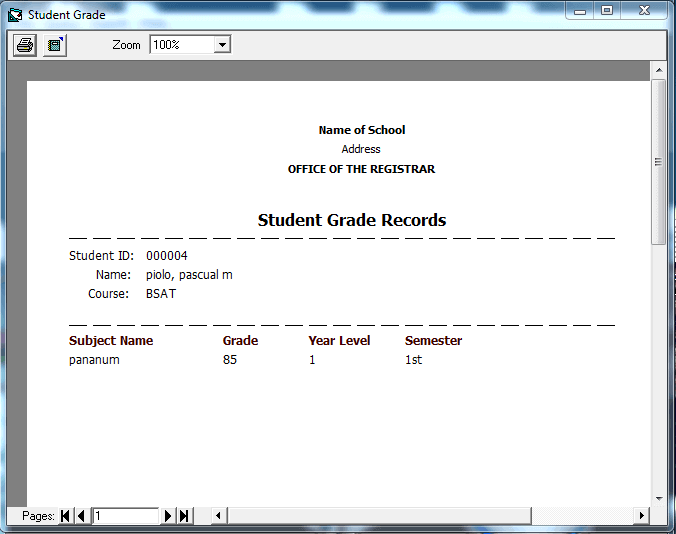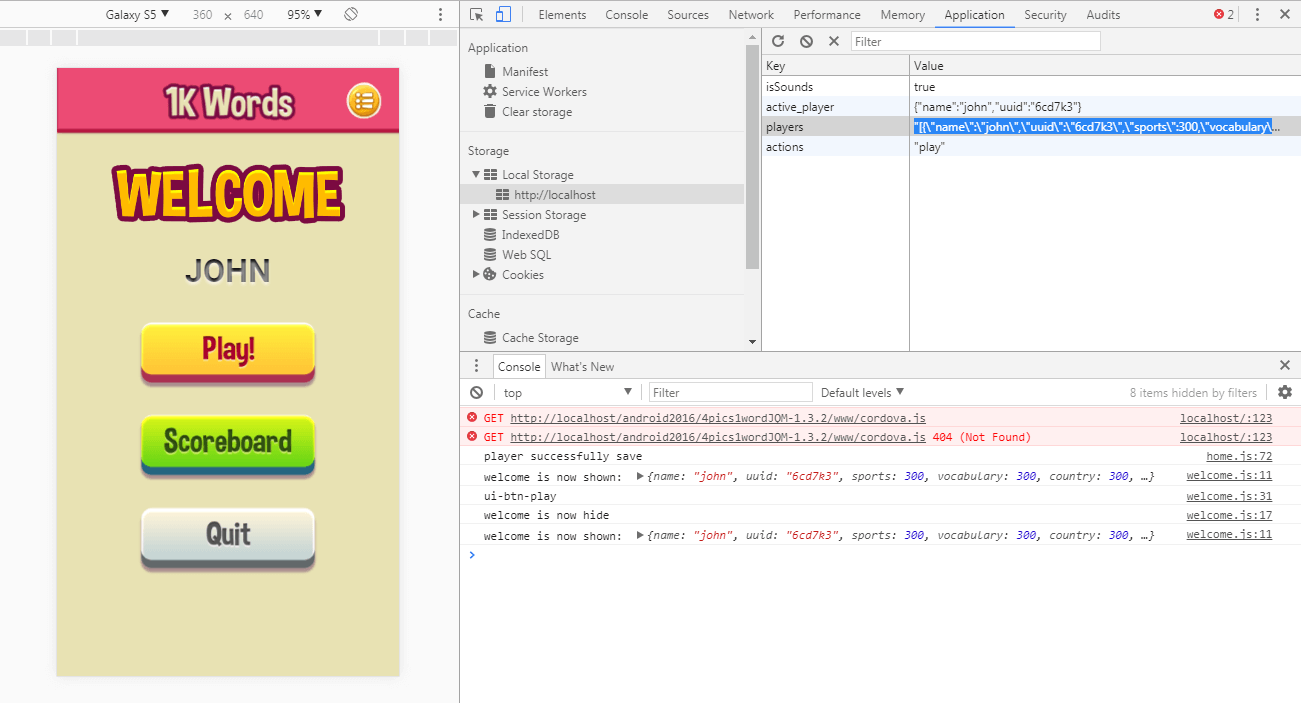IPO Model Conceptual Framework of Complaints Management System
This article will show you how to create a conceptual framework for the capstone project titled Complaints Management System. The input, process, output (IPO) model was used to create the conceptual foundation for this investigation.
About the Project
Table of Contents
The existing way of managing complaints is done manually and involves loads of paper works. The conventional way is time-consuming for both the complainant and those who attend to the complaints. Complaints are hard to manage, monitor, and resolve. The existing manual way is considered inefficient, especially in responding quickly to complaints. Filing and addressing the complaint takes a lot of time and effort for both parties. Online Complaint Management System is a capstone project that is designed to serve as a platform to address complaints and resolve disputes. The system provides an online way of resolving problems faced by the public or people within the organization. The system will make complaints easier to coordinate, monitor, track and resolve.
Readers are also interested in: COVID-19 Online Platform for Complaints and Communication System
Objectives of the Study
- The system will manage the filed complaints of the users or customers virtually.
- To provide an efficient way of handling complaints.
- Output of the capstone project will provide easy and very accessible to the users.
- To develop an information system that will increase the response time to the complaints and resolve the problem quickly.
- The system will eliminate the paper works in handling documents for complaints.
Complaints Management System Conceptual Framework

The image above is the conceptual framework of the project entitled Complaints Management System. It is based on the IPO model or also known as the input, process, and output model.
Input
The input phase or the knowledge requirement stage consists of the following:
- Problem Statement and Opportunities – the researchers selected to conduct a study on Complaints Management systems.
- Interview and Observation of the current process – the researchers conducted a preliminary interview and observation method to further understands the processes involved in the current ways to collect complaints.
- Sample forms and reports – the researchers also gathered the sample forms and reports. This serves as a guide in the preparation of form design and reports of the system.
- Related Literature and Systems – the researchers researched the different kinds of literature and related systems to serve as a guide in the development of the Complaints Management System.
Process
Method of Research
The researcher employed descriptive-developmental research methods. The typical processes of planning, conducting, and reporting a research project—problem definition, literature reviews, and research procedures—are described in this paper (link.springer.com). Descriptive research explains what the study is about. The study focuses on the current condition, to discover new truths. It is concerned with existing relationship conditions, methods that succeed, ongoing processes, and developing effects. Descriptive research entails components of interpretation of the relevance of what is presented, with the primary emphasis on the finding of ideas and insights (www.slideshare.net).
Readers are also interested in: Complaints Handling and Evaluation System Review of Related Literature
Method of Collecting Data
The researchers used interviews as a way to get in-depth and gather data. It consists of one person interviewing another person for personal or detailed information. The interviewer will ask questions from a written questionnaire and record the answers to summarize the findings.
Development of Research Instrument
Before collecting data, the researchers built their research instrument. The Good and Skate questionnaire was used to validate this self-created assessment by three experts. The researchers employed common criteria defined in McCall’s Software Quality Model surveys to test the system’s quality.
Software Development Life Cycle
Analysis and Quick Design
During Analysis and Quick Design, the researchers performed an interview with the respondents in the location of the study. Respondents were allowed to make suggestions and requests about how the system should be created and developed. Following data collection, the researchers created an early design for the developed system.
Data Analysis
The researchers analyzed all the data, information, and user requirements. In this phase, the project lifecycle began. The researchers tried to understand the data and information on how to create the system and help conceptualize how the developed system would begin beneficial to the operators. It analyses the needs of the end-users to ensure that the new system can meet their expectations.
System Design
The researchers started to develop the system. This phase describes the requirements, features, and operations that satisfy the functional requirements of the developed system in place. This phase decides how the system operates.
Readers are also interested in: Complaints Handling Management System

Prototype Cycle
This phase comprises the process of developing a system model, demonstrating it, and refining the data acquired. The researchers initially created a prototype model based on the planned design, which was then shown to the responders. After constructing the prototype, the researchers demonstrated the system’s operation, the flow of how it operates, and the functions of the elements included in the system. Refinement is the final stage. At this stage, the researchers updated the system based on the extra requirements of the operator. This included improvements to the flow, functionality, and features based on the needs provided by the respondents. This aided the researchers in generating a preliminary set of system requirements.
Testing
This includes the feedbacking of the developed system that was installed and tested by three (3) experts and its intended users. This part is put into production by moving the data and components from the old system to the new system.
Output
The study’s ultimate output is a Complaints Management System that would assist them in handling client complaints and resolving them fast. The project’s output may include reports that might assist decision-makers in taking appropriate actions and interventions.
A complaints management system is a valuable tool for businesses in terms of improving customer satisfaction. The advantages and benefits of such a system are numerous, but can be broadly grouped into two main categories: improved communications and increased efficiency.
In terms of communications, a complaints management system provides a more efficient and effective way for businesses to receive customer feedback. Rather than relying on customers to contact the company directly, a complaints management system allows customers to submit complaints through a dedicated channel, which in turn helps to streamline the process and ensure that all relevant information is received. This not only improves customer satisfaction by ensuring that their concerns are addressed quickly, but it also reduces the amount of time that customers spend contacting the company directly, which can be valuable resources that could be better deployed elsewhere.
In terms of efficiency, a complaints management system can help businesses to manage their customer feedback more effectively. By compiling all relevant information received from customers regarding a specific issue, a complaints management system can allow businesses to identify and address common issues quickly and efficiently. This can help to improve customer satisfaction, as customers will see their concerns addressed in a timely fashion and feel that their voices are being heard.
Overall, a complaints management system is a valuable tool for businesses in terms of improving customer satisfaction. By providing a more efficient and effective way for customers to express their concerns, the system can help to address issues quickly and ensures that all relevant information is received. Additionally, by managing customer feedback more effectively, the system can help to improve customer satisfaction overall.
Summary
This article focuses on the conceptual framework of the study as defined by the input, process, output (IPO) model. The input phase, also known as the knowledge necessary stage, includes a Problem Statement and Opportunities, an Interview and Observation of the Current Process, Sample forms and reports, and Related Literature and Systems. The steps of the process are as follows: Research Design/Method of Research, Data Collection Method, Sampling Design, and Software Development Life Cycle. The study’s final product is a Complaints Management System, which will assist them in handling consumer complaints and rapidly resolving them. The project’s output may include reports that might assist decision-makers in taking appropriate actions and interventions.
You may visit our Facebook page for more information, inquiries, and comments. Please subscribe also to our YouTube Channel to receive free capstone projects resources and computer programming tutorials.
Hire our team to do the project.


